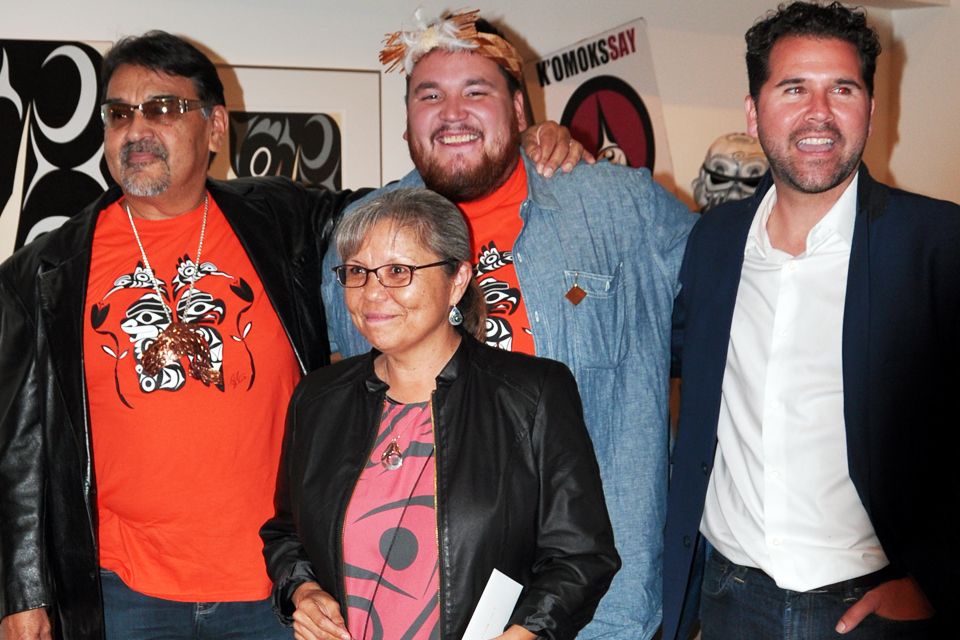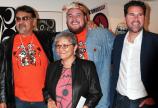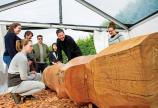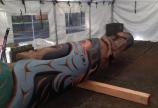Honouring and preserving Indigenous poles of the Pacific Northwest

Indigenous poles and monumental wood carving have been commissioned, installed and restored throughout our region in recent decades, sparking keen public interest.
“Poles tell the story of who we are,” said Chief Rande Cook (K'alapa), a contemporary multi-disciplinary artist with a studio in Victoria’s Rock Bay district and the 2016/17 visiting Audain Professor of Contemporary Art Practice of the Pacific Northwest for UVic’s visual arts department, during an event at the end of September at UVic’s downtown art gallery.
In April, the S,yewe Legend Pole carved by Coast Salish artist Charles Elliott in the 1990s, was taken down and restored carefully in the UVic quad after extensive water damage was discovered. The refurbished pole was raised this spring on a new mounting system.
During the weeks of restoration work, Director of UVic Legacy Art Galleries Mary Jo Hughes began to consider how best to help the wider community in Greater Victoria to “delve deeper into understanding, honouring and caring for Indigenous poles and monumental wood carving.”
“Is there a lack of understanding or taught knowledge in non-Indigenous communities about the cultural significance and narrative symbolism of totem poles in Victoria? What is the proper protocol for care and preservation of the poles? And how do we learn about this?”
On Sept. 30—also Orange Shirt Day across Canada—four exceptional artists including Cook, one moderator, a visiting lecturer and 70 members of the public came together at Legacy Downtown, UVic’s free public gallery, for HIWEST: Forum and Panel Discussion on Creation, Honouring & Preservation of Pacific Northwest Indigenous Poles / Monumental Wood Carving.
HIWEST, which means “to honour,” featured Cook, who is also chief of the ’Namgis Nation; world-renowned Coast Salish artist Doug Lafortune, a member of the Lummi Band in Washington and Tsawout Band in Saanichton; UVic visual arts MFA student Hjalmer Wenstob (Tlehpik), a Nuu-chah-nulth artist from the Tla-o-qui-aht Nation; and Lou-ann Ika’wega Neel from the Mamalillikulla and Kwagiulth tribes of the Kwakwaka'wakw (Kwak’wala-speaking people). The event was opened with a blessing by Timmy Masso, brother of Wenstob.
Four artists of the HIWEST panel
Cook said, “While firstly I consider myself as a Northwest Coast contemporary artist, I draw from traditions and origin stories and my work is always deeply rooted in the culture from which I came.”
“It is interesting to speak in front of people,” added Lafortune during his remarks at the evening event. “Most of the time I work alone but this gives me space to talk about what I do and why I do it.”
“There is nothing I’d like to do than spend the rest of my life carving. I would also like to encourage other young women to carve because when I was young I was told as a woman I should not carve,” said Neel, whose grandmother Ellen Neel was the first woman carver of her time. “What we need to work on now are things like artist contracts, copyright, policy and protocols.”
Wenstob added, “In making these works, we are not making art, we are making part of who we are. A cedar tree grows and as carvers we do our best to honour the cedar tree and give it a second life.”
UVic visual anthropologist and curator Andrea Walsh—who specializes in 20th-century and contemporary Indigenous art and visual culture in Canada, as well as theoretical and methodological approaches to visual research—moderated the panel.
The evening also included traditional Indigenous food from Songhees Seafood & Steam, as well as an introduction to the care of poles and monumental wood carving using a selection of examples and particular treatment approaches, presented by Heidi Swierenga, senior conservator at the Museum of Anthropology (MOA) at UBC.
Swierenga spoke about how after decades of stewardship of poles, MOA has recognized the importance of having relationship with artists, asking artists how they want their poles cared for and preserved, and working with them when the poles need work.
“There is such an appetite to learn more about the traditions, practices and meanings and to experience the narrative and cultural significances,” adds Hughes. As a next step, she is looking into the possibility of collaboration on a printed map of Indigenous poles and monumental wood carving in Greater Victoria.
This event was offered in partnership with Legacy Art Galleries and the City of Victoria.
Visit www.victoria.ca for more on the Sept. 30 event and detailed bios.
More on the Elliott pole restoration
Photos



